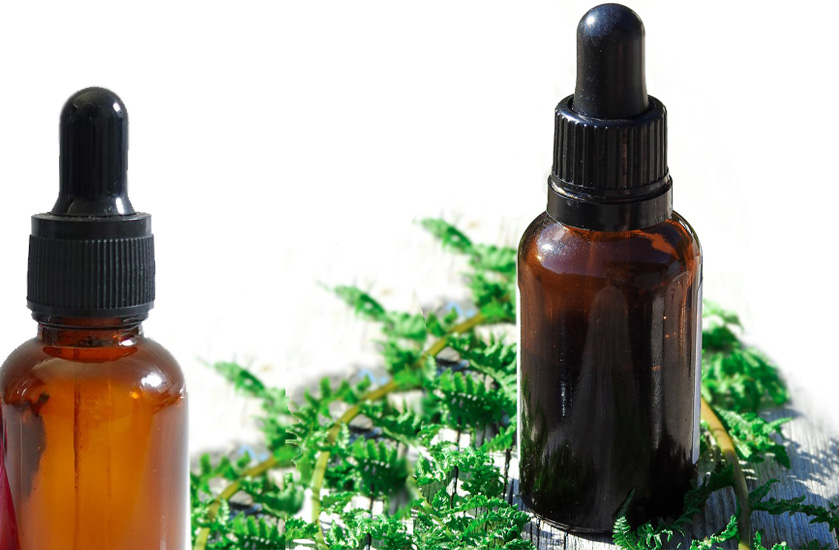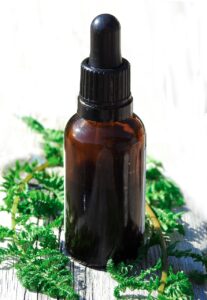DIY herbal remedies are a great way to save money and ensure you know exactly what’s going into each remedy.
Today we’re talking about how to start making herbal tinctures and extracts for your own health and well-being.
In this post, you’ll find answers to:
- What herbal tinctures and extracts are
- How to choose your herbs
- How to make an extract
- Howto make a tincture
- Understanding storage and shelf life
This process isn’t difficult at all, and it can be a fun and rewarding way to connect with nature and bring healing to your body.

1. What are Herbal Tinctures and Extracts?
Herbal tinctures and extracts are natural, concentrated liquids that embody the essence of herbs and botanicals.
They are a wonderful way to make use of the healing power of plants, and can easily be made at home with a bit of knowledge and the right materials.
Tinctures and extracts are powerful formulations of herbs that offer many advantages over other forms. They are made by steeping or boiling herbs in alcohol or glycerine, which extracts the active compounds and allows for easy absorption by the body.
Tinctures and extracts have a longer shelf life than teas and are often more concentrated than capsules. Not to mention, the drops are easier to take than a handful of capsules, or even multiple cups of tea!
The best part? Making herbal tinctures and extracts at home is easier than you might think.
By exploring the world of herbal tinctures and extracts, you can take advantage of a time-tested way of promoting health and well-being, using the bounty of nature to support your body and mind.
So, let’s start exploring this exciting world of plant medicine…
Making Herbal Tinctures and Extracts
2. Choosing Your Herbs
One of the most important aspects of making herbal extracts and tinctures is choosing the right herbs.
Depending on your health needs and personal preferences, you might want to research which herbs have the properties you’re looking for.
Some common herbs used in extract-making include echinacea (immune-supporting), chamomile (relaxing), and peppermint (digestive aid). You can purchase herbs from a health food store, local farmer’s market, or you can buy organic bulk herbs on Amazon here.
Personal Note: I’ve made a lot of tinctures over the years for myself and family. I used to take my herbal tinctures by adding them to a shot glass, counting the drops of each preparation for accuracy in dosage. At first, I took them all at once in the morning, but I felt a little “buzzed” for a bit, due to the alcohol. Back when I started, I didn’t know — or think — to dilute the liquid in one cup of warm water or tea to help evaporate the alcohol! (More on this later.)
Okay, so… when you have chosen your herbs, make sure to rinse them thoroughly to remove any dust or debris. You may also consider drying them in a low-heat oven and crumbling them with your fingers until they become a coarse powder.
Now we are ready for the next step…
3. Making Herbal Tinctures
Fill a jar with your chosen herbs and pour in enough high-proof alcohol to submerge them by at least an inch or so. Tighten the lid and place the jar in a dark place for weeks* until the alcohol has infused with the herb.
*For most herbs, you can let them steep for four to six weeks. This gives them plenty of time to release their beneficial properties into the alcohol or other solvent.
Of course, there are always exceptions, so it’s important to do your research and follow a recipe or guide that specifies the steeping time for your chosen herb.
Every day (as I remembered to do it), I also softly swirl them around in the jar to give them the fullest exposure to the extraction liquid.
After this process of infusing the herb(s) is complete, use a cheesecloth to strain out the solid bits of herbs. You will be left with a dark, rich liquid.
Pour this into a dropper bottle for easy dispensing, and store it in a cool, dark place to keep it fresh. (Does not need to be refrigerated.)
With a little patience and care, you can create potent, natural remedies that support your health and well-being.
4. Making Herbal Extracts
The process for making a extracts is similar to tinctures.
The first step is to make the extract using the double extraction method.
Fill a glass jar about 1/2-2/3 of the way with your selected herbs. You can choose one herb or make a mixture of several herbs for a customized blend.
Pour a high-proof alcohol, such 100 proof as vodka, Everclear, or brandy, to submerge the herbs completely. (See other options to replace the alcohol below.)
Close the jar tightly and store in a cool, dark place for a few weeks to several months. The length of time depends on how strong you want the extract when done.
As with tinctures, after soaking, strain the solid herbs out of the alcohol mixture through a cheesecloth.
Keep the liquid and discard the solid parts. The liquid is your herbal extract!
Using Your Herbal Tinctures and Extracts
There are many ways to use herbal extracts and tinctures…
You can apply it directly to the affected area, use it as an inhalant, or mix it into food or beverages.
Be sure to follow suggested dosages as specified by your herbalist, nutritionist, or natural health practitioner. Or, at least, research it well!
Do I have to use alcohol?
As mentioned in my personal note above, if you take a bunch of tinctures or extracts together at one time, you can get a bit of a buzz. So…
There are a few options to avoid these effects when taking tinctures and extracts made with alcohol.
One is to simply dilute the tincture or extract in one cup warm water, tea or juice before consumption. (This helps evaporate the alcohol somewhat.)
Alternatively, you can make a glycerin-based* tincture instead of an alcohol-based one.
Another option is to make a decoction or strong tea with the herbs. This will still extract some of the beneficial compounds but without the alcohol content.
*What is a glycerin-based tincture?
Simply put, a glycerin-based tincture is just that: a tincture made with vegetable glycerin instead of alcohol.
This makes it an excellent option for those who want a non-alcoholic alternative, such as children or those who avoid alcohol for personal reasons.
Glycerin is a sweet, syrupy substance that is easy to work with and has a mild taste that won’t overpower the flavor of your herbs.
Don’t let the thought of alcohol deter you from making tinctures – give glycerin a try!
 5. Storage and Shelf Life
5. Storage and Shelf Life
To ensure your extracts and tinctures stay fresh and effective, store them in a cool, dark spot. They should not be exposed to direct sunlight or heat.
You can use amber dropper bottles or jars to prevent light from penetrating the liquid.
Always label your creations with the contents and creation date.
Making Herbal Tinctures and Extracts
Making your own herbal extracts and tinctures can seem intimidating, but with the right ingredients and equipment, you can create your own customized blends to suit your specific health needs.
By creating these remedies at home, you can save money and have the peace of mind that comes from knowing exactly what you’re putting into your body. Use this guide to get started and enjoy the many benefits of natural medicine!
Have fun!
P.S. Refer to my Herbal Preparations page for more.

 5. Storage and Shelf Life
5. Storage and Shelf Life